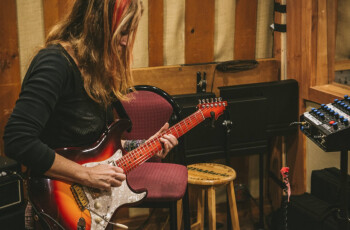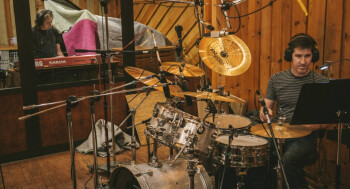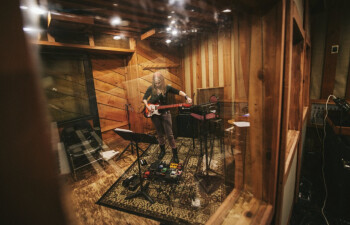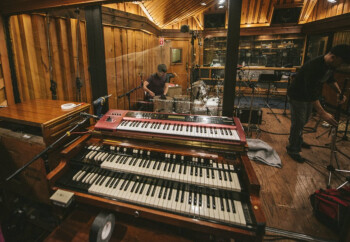Jane Getter's powerful jazz/progressive guitar playing is the focal point of “On,” the new album from her band Jane Getter Premonition. The record also features the virtuosic keyboard work of her husband, keyboardist Adam Holzman (Miles Davis, Steven Wilson) as well as the contributions of a group of "A-list" players including bassist Bryan Beller (Joe Satriani, The Aristocrats), drummer Chad Wackerman (Frank Zappa), vocalist Corey Glover (Living Color) and guitarist Alex Skolnick (Testament, Alex Skolnick Trio).
Getter, who is a former member of the Saturday Night Live band, has three previous solo albums to her credit. On, which was just released several weeks ago on Madfish records, was recorded at Avatar studios in New York City, a large commercial studio.
Audiofanzine had an opportunity to chat with Getter and Holzman, who co-produced On, about the making of the album, Getter’s guitar style and gear, and a lot more.
The new album sounds great. Did you choose a large studio like Avatar because of the sound you can get there?
Adam Holzman: Jane and I have had a long history at Avatar (formerly called Power Station). Our manager, who we no longer work with, had a long association with Power Station, and we ended up on the “friends and families” circuit there. So we both have been very lucky, we’ve done all our projects there. We’ve gotten great deals. But it also happens to be the best sounding place around. I feel very strongly about the sound of this room, and the sound of the mix rooms, as well.
Jane Getter: My first three albums were recorded there, in a different studio though.
Were you in the big main room?
JG: No. This one was in [Studio] C. But all my other three albums were in A.
AH: The thing about Avatar is that the way they handle their staff is reminiscent of the apprenticeship system in England, where you start of making fruit bowls for a year, before you get anywhere near a fader or a record switch. So they have these guys that they basically trained. And I’d be willing to bet that an assistant engineer at Avatar is probably better than most regular engineers out there.
JG: Anthony Ruotolo, the engineer that recorded this album, started out as an assistant in Avatar. And he was the assistant on my first album, actually. He was house engineer for a long time. And then he did three. The one before this he was the engineer and then he did this one also.
AH: Now he’s doing Good Morning America.
Talk about recording the album. Did you record everything live except the vocals?
AH: The basic tracks are all live. I would say 90 percent of the band tracks, basic keyboards, the original guitar, bass, drums, all that stuff is live.
AH: The answer is yes. There were a bunch of additional overdubs, but the core of it was recorded live. And that’s one of the great things about going to a studio like Avatar. Fire up the whole band, have every instrument sound really amazing, and then you go back into the control booth and you listen back to it. And then bang. your song is done. It’s not like you’re waiting around to email it to a bunch of people.
JG: That energy of playing live, it’s a whole different feeling.
Was everything pretty much isolated?
AH: Yes. The drums were in a big wooden room that had three adjacent rooms with sliding glass doors. We did guitar in one and keyboard in another.
JG: And then Alex [Skolnick] who was there for one day, was also in the big room, but his amp was in the control room.
You could all see each other when you were playing?
JG: Yeah.
AH: We had sightlines.
So it really was pretty much like playing live?
AH: For the most part. You could always repair things, but you can still retain the energy.
So since everything was recorded in isolation, you could do punch-ins and stuff if you needed.
Were the solos overdubbed?
JG: The solos were live. The only solo that I did that was an overdub was for the song “Logan." I actually did it here in the house. But all the other solos are live.
Adam, did you mix it at Avatar?
AH: No, we mixed at Spin in Queens. We wanted to mix it at Avatar, but we just couldn’t afford to do it that way. At the same time, I wanted to mix it the old-fashioned way. Go in the studio with the engineer and fire it all up through the faders and mix it in sort of a traditional style. As opposed to going to someone’s house while they fiddle around on their computer for hours and hours and you end up watching your life pass before your eyes, and then you come home and you’re still not sure about it. When you fire it all up in the studio with their components and their outboard processing, you get the pristine quality of their signal path. Even a medium quality studio is still better than anything you could do at home in the box. I think that stuff that’s mixed purely in the box ends up sounding kind of, I don’t know, overly compressed, kind of boxed in, and doesn’t have a normal dynamic feel to it.
How big were the sessions in terms of track count?
AH: About 40 tracks, typically — pretty big, but not humongous.
And because you were doing the mixes on a large console, did that mean you had no recall options other than writing everything down?
AH: We did the volume moves in the computer. But they were going through the faders. So if you zeroed out all the faders and fired up the tracks from the computer, the basic balances would be intact.
Did you do EQing on the console?
JG: Yeah, oh yeah.
So you had to write all those settings down.
AH: They did traditional recalls. We had to go back a couple of times and open up the casket and make a small fix. But yeah, the old fashioned way. That’s one nice thing about doing it in the box. You work on a mix incrementally. But with this, you sacrifice a little bit of perspective for being able to have that sound where everything is just fired up at once going through a great board. You just don’t get that at home or in the box.
One of the things about the mix I thought was really cool was what you guys did with the vocal sounds.
AH: Which song?
For example, on “Surprised, ” the one Corey Glover sang on. It was kind of like a telephone-y kind of thing but ethereal at the same time. I’m curious how you got that.
JG: I’ll just say, we had some help with a couple of songs for [mixing the] vocals.
AH: A secret admirer sprinkled some fairy dust on a couple of the tracks.
[Laughs] Well, whatever they did, they did a great job. The vocals were very unusual and different, and they sounded great.
AH: At the same time, some of the basic ideas, like the telephone voice and the clean voice, that was us.
There were similar effects on your voice, Jane, right?
JG: Well “Surprised” has a distorted thing on the voice. And then on “Falling” there’s a background that has a distorted thing happening.
AH: There were guitar amp plug-ins for some of the distortion, as opposed to the telephone thing. Your average guitar amp plug-in gets that effect, I think, a little more satisfyingly than doing it with EQ or distortion.
Let’s talk about your guitar sounds Jane. What kinds of guitars were you using mainly on the album?
JG: The main guitar that I used on the album was made by a company called “Peekamoose, ” a custom guitar. It’s a small guitar shop in New York City, and the guy that made it was originally the Fender repair person. And I met him through that, because I was a Fender artist for a little while. He was working on my guitars for a few years, and then he surprised me with this beautiful guitar. It’s a Strat style guitar with humbuckers, which is perfect for me. Since he’d been working on my guitars for years, he knew how I liked to set them up, and he knows my colors. I just did a gear video which is going to come out soon. But if you look at the documentary, you’ll see the guitar. So I used that on most of the album. I also used a '71 Tele that I have, that I used on “Train Man.” And I have a custom Strat that Fender made for me, that’s styled after a 1960's Strat, that’s on a couple of tunes, also. But my main guitar is the Peekamoose.
Did you use a particular amp for the sessions?
Yes. Do you know Andy Fuchs? He’s out of Clifton, New Jersey. It’s another small boutique fantastic amp. It’s a head, the Fuchs Full House 50 with a 2×12 cabinet. And that’s the only amp I used on the whole album. I used just board delays and reverbs and stuff like that [for ambience]. I used the amp for the main distorted sound and the clean sound. I do have this one Maxon overdrive pedal that I used for the softer distortion. Like on the solo at the end of "Falling.” The rest is all studio plug-ins and stuff – all the other effects.
And what about when you play live, do you use a lot of pedals?
JG: I have a big pedalboard, yeah.
What are some of the pedals in your rig.
JG: I really love this analog delay made by Jam it’s called Delay Llama. And I use a volume pedal, just a Korg. I used Ernie Ball volume pedals for years, but the one I have is broken, and it’s so big, so I started using the Korg. And I use a Vox wah wah. And I have a few different distortion pedals that I use when I don’t have my amp: I’ve got a couple of Seymour Duncan ones that I use. I also have a TC Electronic chorus, and I use the flange for the wiggly kind of sound I use sometimes. And that’s pretty much it. I do have a compressor that I use occasionally, an MXR. And I just got a Distillery by Tone Concept, which is a really interesting pedal. It’s kind of like a preamp booster. I just got it, and I’m still working with it, but it just kind of always makes you sound better. [Laughs]
Do you use the volume pedal so that you don’t have to back off your guitar volume knob, or do you just use it for effects?
JG: Sometimes I do swells with the volume pedal. But I just like to adjust my volume a lot when I’m playing.
And you’d rather do it there than with your guitar volume knob? Is that because you don’t want to lose highs when you back off on the volume knob on the guitar?
JG: Exactly. I like to keep it basically up the whole way, and control with the volume pedal.
Did you do much of the pre-production for the album in your home setup?
JG: Yeah. This is actually the first time I’ve done this. I did all the demos in Logic up in my studio, and I played everything and programmed the drums and stuff. We used a couple of the parts — a couple of the keyboard sounds and parts from my demos.
What about the keyboards on the album, Adam? Did you use mostly real keyboards or virtual ones, or what?
AH: It was mostly real. It was a real Hammond B-3. A regular Yamaha Acoustic Piano, a Fender Rhodes and a Minimoog. Occasionally, I did like a string pad or something like that on a Korg Karma, which I’ve had for a long time. I like some of the stuff on it. Basically, the same sound engine as a Triton. The Mellotron sounds are from Logic, but it’s from a library of Mellotron samples that Steven [Wilson] gave me.
You also play with Steven’s band. How’s that going?
AH: It’s been great. I’m on a break right now in the middle of a pretty extensive tour. We’ve been on the road for almost eight months this year. He’s got a new record that came out earlier this year that’s really doing well all around the world, called Hand Cannot Erase. It’s a great gig for me, because the keyboard chair has a lot of opportunity to really play. My main solo instrument is usually the Moog Voyager, which I’m a big fan of. I really admire some of these companies, like Moog, that have done a good job combining the retro vibe with modern dependability.
Are there any virtual instruments that you really like?
AH: The virtual instruments that I really like are the ones that are as bizarre as possible — the ones that could only exist in a laptop. And the sampler kind of stuff, I guess. But as far as a virtual instrument that’s going to replace either an electric piano or a Minimoog, there’s nothing to me that comes close. I use a Hammond module. I guess that’s virtual. But it’s made by Hammond and it has a dedicated set of drawbars and its dialed in and you get a variety of Organ sounds that you could never get out of a laptop.
But a lot easier to carry than the real thing. [Laughs]
AH: But once you mic it up on a big, loud stage, the differences become really, really small. You’d be hard pressed, if it were mixed into a track, to tell the difference.
Jane, have you always played jazz and fusion kind of stuff, or did you start out playing other styles?
JG: You know, I’m a girl. I played acoustic guitar. I played folk music, and blues, actually, when I was much younger, and a little bluegrass at some point, playing mandolin. And then I started playing jazz, I started taking jazz lessons, and I got into electric then. My first jazz guitar, which I still have, is a 1953 ES-175.
That’s probably worth a little bit. [Laughs]
JG: Yeah. And then I got really into mainstream jazz. Straight ahead. And that’s all I listened to and all I played. And then I started kind of getting into more groove oriented [stuff], backbeats. And the rest is history, I started hearing more rock and funk.
When you were playing straight ahead jazz, did you feel constrained at all by the fact that you had to have a clean tone, and not bend, and all that?
JG: Not really, because I never really did anything but that previously. I knew how to bend a little bit, but I wasn’t coming from a rock place. Even though I loved listening to rock, I never really imagined myself doing that. Maybe that’s a girl thing. There weren’t any role models, until I saw Bonnie Raitt, you know what I mean? I don’t know if that had anything to do with it or if I just wasn’t hearing it then. I didn’t feel constrained in that respect. .
When were you in the SNL band?
JG: That was in the late '90s.
What was that like?
JG: That was pretty amazing. It was a serious reading gig. You really have to be able to read your ass of on that gig. You do one rehearsal in the morning, and then you do the soundcheck and the show. And everything is written out. You’re in a band with all these horn players that can read fly shit, you know. And I was always hanging out, on my breaks, trying to learn my stuff. [Laughs] I mean, I’m a decent reader. But I’m still a guitar player.
Being a decent reader for guitar is not the same as for a different instrument. [Laughs]
JG: You have one note that you can play in about seven different places. What position are you going to play it in? And all that stuff.
There was only one guest artist for each SNL show, right?
JG: Yeah, and you do all the music in between commercial breaks. And you keep playing. When it goes to commercial, you keep playing.
Was it different material each week for the in-between commercials music?
JG: Yes.
How many days of rehearsal did you have to do each week?
JG: Just one rehearsal. You don’t get sent the music in advance. You go in and sight-read it. And sometimes during the week you do commercials. You know how they show those funny commercials? When the band is on that, they record that during the week.
What’s the plan as far as the album goes, are you going to do a lot of touring for it?
JG: We’re doing a States tour in December, starting off in Cleveland, and ending up in New York. We’re doing Detroit, Buffalo, D.C., Philly, Asbury Park, and I think Woodstock. It’s just like a week. And we’re going to go to Europe in February.
[Opening photos and Avatar studio photos by Lasse Hoile]





